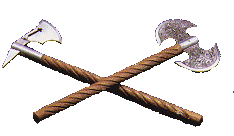


Divine Questions And Answers
Q) The "Book of Journeys" notes that Christ ascended into Heaven when he was 33 and that the Cross is a stylized star symbol. "The Amber Cathedral" module, on the other hand, makes multiple references to Christ having been crucified, hence the Crucifix symbol. What actually happened?
A) Fantasia tries to create the mood without creating any definitive religion. Too often gamers memorize the endless (and in my opinion needless) encyclopedias of a fantasy setting to try and get an edge. I admit, stories are great, but what do they add to a game? The best stories are the ones in a Player's own mind. To that end, the Fantasia "canon" is kept as vague as possible. I mention "Christ" in order to firmly establish Fantasia as a more Arthurian, classic, medieval European world, as you can't really have "Christ" along with the traditional gameworld pantheon, as It's really got to be one or the other. However, for artistic reasons, "Christ", "Holy Tomes" and "God" are about all I mention. I certainly don't want to incite any religious debate amongst gamers at the game. The more specific things like "He ascended at age 33" and "being crucified" are, while seeming specific, actually still very vague, allowing the Game Master to tailor the world to his Campaign's needs. They're teasers, really. If you think of the Grail Quest, a "tale in which everybody knows what happened yet they know none of the details", that's how I prefer Fantasia to be. So various, commonly known elements of the tale are thrown out there for flavor, but really don't pin down hard details. The real story is up to you. As for how *I* would see it or do it at my own game table personally, as the world's creator, Christ was crucified by some evil warlord because it's a villainous thing to do (think of the XP a villain would get for killing God!) but Christ, being, well, pretty damn powerful, did more of an Obi-Wan Kenobi manuever and "became more powerful than the villain could possibly imagine", so he allowed himself to be crucified, then ascended, perhaps to teach a vital lesson to the Crusader heroes watching on, who eventually took the villain down. But that's just one possibility.
Q) Isn't a kiss to remove a Blight a little too easy?
A) A kiss is more than just the action thereof. A true kiss, indeed one strong enough to purify a Blight, must either be done truly out of love (as proven through role-playing) or the culmination of a wedding ceremony. Admittedly the rules are vague at best on this. Our mistake.
Q) When someone who does not have Faith uses the D8 for prayers, why does he also use the D8 for the results of a failed Prayer Check instead of the D12?
A) Having to use the D8 for both the Prayer and any failure as well (Table 43) greatly increases the risk and thus does not diminish or undervalue the true Classes and others with Faith who should indeed be able to accomplish far more.
Q) The way that the strengths of the Uru are written, it sounds as if only Dwarves can benefit from those blessings (Table 48), but is this truly the case?
A) Nor indeed. Anyone can benefit from any strength from Table 48. The way that is written, referring to 'Dwarves' rather than 'Characters', is simply because Dwarves most commonly use such strengths, and also to reflect how proud the Dwarves are, as they alone appreciate the Uru and thus their name is used when referring to power gained thereby.
Q) If a Half-Elf gains the Power of Faith, what Table does he use in Chapter VII?
A) The Half-Elf's choice of which world to stand in is made with his Character Class. Thus, if he chose a human Class, he would also follow human faith, using Table 45. If he chose an Elven Class, he would follow more the ways of the Immortals, thus using Table 46.
Q) How come it is more difficult for Druids to change form than for others with such faith?
A) Changing form is not a natural ability for a Druid, whereas the category of 'others' includes all sorts of strange folk, wild men and those who are beasts by nature, and thus are more likely to find changing form to be a natural act.
















